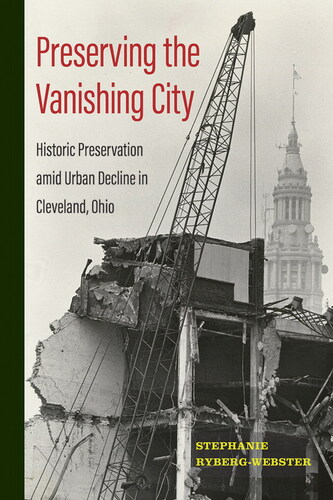Cleveland (OH) boomed as an economic powerhouse in the late 19th century. John D. Rockefeller chose the city to establish the Standard Oil Company in 1870, developing an economy that attracted waves of immigrants. In 1920, Cleveland was the fifth-largest city in the United States, behind New York (NY), Chicago (IL), Philadelphia (PA), and Detroit (MI). Downtown flourished, with factories, office buildings, warehouses, and several other commercial enterprises. East of downtown, civic and cultural development blossomed, including the University Circle, which became a hub of cultural and medical institutions. The city population peaked in the 1950s, but a rapid decline followed deindustrialization, and by the 1970s there were too many houses, commercial spaces, factories, and offices in Cleveland. This situation resulted in a widespread policy of demolition—as a dominant response to deterioration, vacancy, and abandonment—raising multiple challenges and dilemmas for preservationists.
Stephanie Ryberg-Webster tells the story of the preservation movement in Cleveland during those years of urban decline in her book Preserving the Vanishing City: Historic Preservation amid Urban Decline in Cleveland, Ohio. In a heartfelt narrative that reflects her deep affection for the city she calls home, Ryberg-Webster provides a compelling account of urban preservation in the United States. Through the case study of Cleveland, readers gain perspectives on how preservationists had to develop entrepreneurial strategies to enter the planning and community development sector during an era of urban decline. It’s a book that illustrates the glory and struggles of Cleveland and at the same time contextualizes its history in the overall development of historic preservation at the national level, including its dynamics with planning in the 1980s. Most important, Preserving the Vanishing City grapples with key historical preservation questions that are essential for understanding the current urban dynamics.
The book re-centers Cleveland as a prototypical legacy city, which has so far been neglected in the literature. The term legacy city was coined in 2011 by the American Assembly, a think tank at Columbia University, to identify those cities that have a rich heritage and assets but also face continuous challenges. Today, the Lincoln Institute of Land Policy leads the Legacy Cities Initiatives and has identified 100 American cities that fit the definition. One aspect that remains the biggest challenge for these cities is that they have not been able to rebound from the population decline in the 1970s. Their urban decline is hard on social conditions and manifests in the built environment, creating challenges for historic preservation. At the same time, as explained in the edited volume Legacy Cities: Continuity and Change amid Decline and Revival (Tighe & Ryberg-Webster, Citation2019), they contribute to the evolution of the nation with their resilience and efforts to reinvent themselves.
Organized into seven chapters, Preserving the Vanishing City begins with an overview of the institutionalization of preservation as a profession in the context of Cleveland. Chapter 2 explains the complex relationship between Cleveland and its industrial heritage. Chapter 3 provides an example of preservation-based revitalization in the Warehouse District, followed by Chapter 4, which explains the DIY movement and collaboration between preservation institutions and neighborhood organizations. Chapter 5 elaborates on preservation and neighborhood narratives in Detroit Shoreway, Old Brooklyn, and Tremont. Chapter 6 focuses on the Buckeye neighborhood, tackling issues of race in areas with immigrants, and Chapter 7 illustrates the disconnect between preservation and community development through the DIY home improvement workshop, primarily focusing on saving housing for the current residents.
The epilogue brings important insights as a conclusion of a thoroughly researched monograph, which is also elegantly written and engaging. Even though the entire book brings the readers through stories that are, as the author says, “simultaneously inspiring and heartbreaking” (p. 21) about Cleveland, the epilogue raises reflections and questions that are deeply urgent and problematic today in many American cities. It brings to the forefront how planners need to engage with preservationists, even though their relationship has traditionally been uneasy (Birch & Roby, Citation1984) and only recently have plans for revitalization included preservation (Redaelli, Citation2020). A few of the key lessons for improving this relationship that emerge from the Cleveland case study include improving coordination in decision making, developing partnerships for collaborative financing, and adopting an incremental and ongoing approach.
Why should planners and policy analysts read this book? Preserving the Vanishing City shows how preservation is local, enhancing the specific history of each place, but it is also affected by the larger national institutionalization of the profession. It offers valuable insights on the dynamics of American cities, characterized by periods of rapid growth, subsequent decline, ongoing preservation efforts, and the pressing need for greater equity.
Additional information
Notes on contributors
Eleonora Redaelli
ELEONORA REDAELLI is a professor at the University of Oregon specializing in cultural policy in the United States, particularly related to the arts, humanities, and historic preservation. She has published several works, including Arts Management and Cultural Policy Research (Palgrave Macmillan, 2016) with Jonathan Paquette and Connecting Arts and Place: Cultural Policy and American Cities (Palgrave Macmillan, 2019), and edited Visiting the Art Museum: A Journey Toward Participation (Palgrave Macmillan, 2023).
References
- Birch, E. L., & Roby, D. (1984). The planner and the preservationist: An uneasy alliance. Journal of the American Planning Association, 50(2), 194–207. https://doi.org/10.1080/01944368408977175
- Redaelli, E. (2020). Including preservation in planning. Journal of the American Planning Association, 87(2), 266–281. https://doi.org/10.1080/01944363.2020.1822753
- Tighe, R. J., & Ryberg-Webster, S. (2019). Legacy cities: Continuity and change amid decline and revival. University of Pittsburgh Press.


